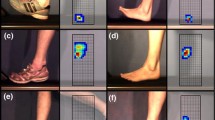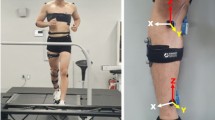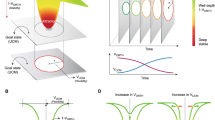Abstract
Foot-ground impact is a critical event during the running cycle. In this work, three performance indicators were used to characterize foot-ground impact intensity: the effective pre-impact kinetic energy, representative elements of the effective mass matrix, and the critical coefficient of friction. These performance indicators can be obtained from the inertial properties of the biomechanical system and its pre-impact mechanical state, avoiding the need to carry out force measurements. Ground reaction forces and kinematic data were collected from the running motion of an adult that adopted both rear-foot and fore-foot strike patterns. Different running cycles were analysed and statistical tests performed. Results showed that the three proposed indicators are able to illustrate significant differences between fore-foot and rear-foot strike impacts. They also support the hypothesis that fore-foot strike reduces impact intensity. On the other hand, a higher likelihood of slipping during the contact onset is associated with fore-foot strike pattern.













Similar content being viewed by others
References
Addison, B.J., Lieberman, D.E.: Tradeoffs between impact loading rate, vertical impulse and effective mass for walkers and heel strike runners wearing footwear of varying stiffness. J. Biomech. 48(7), 1318–1324 (2015). doi:10.1016/j.jbiomech.2015.01.029
Alonso, F.J., Castillo, J.M.D., Pintado, P.: Application of singular spectrum analysis to the smoothing of raw kinematic signals. J. Biomech. 38(5), 1085–1092 (2005). doi:10.1016/j.jbiomech.2004.05.031
Alonso, F.J., Cuadrado, J., Lugrís, U., Pintado, P.: A compact smoothing-differentiation and projection approach for the kinematic data consistency of biomechanical systems. Multibody Syst. Dyn. 24(1), 67–80 (2010). doi:10.1007/s11044-010-9191-1
Altman, A.R., Davis, I.S.: A kinematic method for footstrike pattern detection in barefoot and shod runners. Gait Posture 35(2), 298–300 (2012). doi:10.1016/j.gaitpost.2011.09.104
Belli, A., Bui, P., Berger, A., Geyssant, A., Lacour, J.R.: A treadmill ergometer for three-dimensional ground reaction forces measurement during walking. J. Biomech. 34(1), 105–112 (2001). doi:10.1016/S0021-9290(00)00125-1
Cavanagh, P.R., Lafortune, M.A.: Ground reaction forces in distance running. J. Biomech. 13(5), 397–406 (1980). doi:10.1016/0021-9290(80)90033-0
Chi, K.J., Schmitt, D.: Mechanical energy and effective foot mass during impact loading of walking and running. J. Biomech. 38(7), 1387–1395 (2005). doi:10.1016/j.jbiomech.2004.06.020
Clark, K.P., Ryan, L.J., Weyand, P.G.: Foot speed, foot-strike and footwear: linking gait mechanics and running ground reaction forces. J. Exp. Biol. 217, 2037–2040 (2014). doi:10.1242/jeb.099523
De Wit, B., De Clerq, D., Aerts, P.: Biomechanical analysis of the stance phase during barefoot and shod running. J. Biomech. 33(3), 269–278 (2000). doi:10.1016/S0021-9290(99)00192-X
Divert, C., Mornieux, G., Baur, H., Mayer, F., Belli, A.: Mechanical comparison of barefoot and shod running. Int. J. Sports Med. 26(7), 593–598 (2005). doi:10.1055/s-2004-821327
Farley, C.T., González, O.: Leg stiffness and stride frequency in human running. J. Biomech. 29(2), 181–186 (1996). doi:10.1016/0021-9290(95)00029-1
Font-Llagunes, J.M., Barjau, A., Pàmies-Vilà, R., Kövecses, J.: Dynamic analysis of impact in swing-through crutch gait using impulsive and continuous contact models. Multibody Syst. Dyn. 28(3), 257–282 (2012). doi:10.1007/s11044-011-9300-9
Font-Llagunes, J.M., Kövecses, J.: Dynamics and energetics of a class of bipedal walking systems. Mech. Mach. Theory 44(11), 1999–2019 (2009). doi:10.1016/j.mechmachtheory.2009.05.003
Gerritsen, K.G., van den Bogert, A.J., Nigg, B.M.: Direct dynamics simulation of the impact phase in heel-toe running. J. Biomech. 28(6), 661–668 (1995). doi:10.1016/0021-9290(94)00127-P
González, F., Kövecses, J., Font-Llagunes, J.M.: Load assessment and analysis of impacts in multibody systems. Multibody Syst. Dyn. 38(1), 1–19 (2016). doi:10.1007/s11044-015-9485-4
Hamner, S.R., Seth, A., Delp, S.L.: Muscle contributions to propulsion and support during running. J. Biomech. 43(14), 2709–2716 (2010). doi:10.1016/j.jbiomech.2010.06.025
Hanson, N.J., Berg, K., Deka, P., Meendering, J.R., Ryan, C.: Oxygen cost of running barefoot vs. running shod. Int. J. Sports Med. 32(6), 401–406 (2011). doi:10.1055/s-0030-1265203
Hirschkorn, M., Kövecses, J.: The role of the mass matrix in the analysis of mechanical systems. Multibody Syst. Dyn. 30(4), 397–412 (2013). doi:10.1007/s11044-013-9369-4
Kluitenberg, B., Bredeweg, S.W., Zijlstra, S., Zijlstra, W., Buist, I.: Comparison of vertical ground reaction forces during overground and treadmill running. A validation study. BMC Musculoskelet. Disord. 13(1), 235 (2012). doi:10.1186/1471-2474-13-235
Kövecses, J.: Dynamics of mechanical systems and the generalized free-body diagram, part I: general formulation. Int. J. Appl. Mech. 75(6, 1–12 (2008). doi:10.1115/1.2965372
Kövecses, J., Font-Llagunes, J.M.: An eigenvalue problem for the analysis of variable topology mechanical systems. J. Comput. Nonlinear Dyn. 4(3, 1–9 (2009). doi:10.1115/1.3124784
Kövecses, J., Kovács, L.: Foot impact in different modes of running: mechanisms and energy transfer. Proc. IUTAM 2, 101–108 (2011). doi:10.1016/j.piutam.2011.04.011
Laughton, C.A., Davis, I.M., Hamill, J.: Effect of strike pattern and orthotic intervention on tibial shock during running. J. Appl. Biomech. 19(2), 153–168 (2003). doi:10.1123/jab.19.2.153
Lieberman, D.E., Venkadesan, M., Werbel, W.A., Daoud, A.I., D’Andrea, S., Davis, I.S., Mang’Eni, R.O., Pitsiladis, Y.: Foot strike patterns and collision forces in habitually barefoot versus shod runners. Nature 463, 531–535 (2010). doi:10.1038/nature08723
Lopes, D., Neptune, R., Ambrósio, J., Silva, M.: A superellipsoid-plane model for simulating foot-ground contact during human gait. Comput. Methods Biomech. Biomed. Eng. 19(9), 954–963 (2016). doi:10.1080/10255842.2015.1081181
Low, D.C., Dixon, S.J.: Footscan pressure insoles: accuracy and reliability of force and pressure measurements in running. Gait Posture 32(4), 664–666 (2010). doi:10.1016/j.gaitpost.2010.08.002
Mahboobin, A., Cham, R., Piazza, S.J.: The impact of a systematic reduction in shoe-floor friction on heel contact walking kinematics—a gait simulation approach. J. Biomech. 43(8), 1532–1539 (2010). doi:10.1016/j.jbiomech.2010.01.040
Maiwald, C., Grau, S., Krauss, I., Mauch, M., Axmann, D., Horstmann, T.: Reproducibility of plantar pressure distribution data in barefoot running. J. Appl. Biomech. 24(1), 14–23 (2008). doi:10.1123/jab.24.1.14
McDougall, C.: Born to Run: A Hidden Tribe, Superathletes, and the Greatest Race the World Has Never Seen, 1st edn. Knopf, New York (2009)
McMahon, T.A., Cheng, G.C.: The mechanics of running: how does stiffness couple with speed? J. Biomech. 23(Suppl. 1), 65–78 (1990). doi:10.1016/0021-9290(90)90042-2
Neptune, R.R., Wright, I.C., van den Bogert, A.J.: A method for numerical simulation of single limb ground contact events: application to heel-toe running. Comput. Methods Biomech. Biomed. Eng. 3(4), 321–334 (2000). doi:10.1080/10255840008915275
Nigg, B.M. (ed.): Biomechanics of Running Shoes. Human Kinetics, Champaign (1986)
O’Connor, C.M., Thorpe, S.K., O’Malley, M.J., Vaughan, C.L.: Automatic detection of gait events using kinematic data. Gait Posture 25(3), 469–474 (2007). doi:10.1016/j.gaitpost.2006.05.016
Pàmies-Vilà, R.: Application of multibody dynamics techniques to the analysis of human gait. Ph.D. thesis, Universitat Politècnica de Catalunya (2012). http://www.tdx.cat/handle/10803/123774
Pàmies-Vilà, R., Font-Llagunes, J., Lugrís, U., Cuadrado, J.: Parameter identification method for a three-dimensional foot-ground contact model. Mech. Mach. Theory 75, 107–116 (2014). doi:10.1016/j.mechmachtheory.2014.01.010
Riley, P.O., Dicharry, J., Franz, J.R., Casey, K.D.: A kinematics and kinetic comparison of overground and treadmill running. Med. Sci. Sports Exerc. 40(6), 1093–1100 (2008). doi:10.1249/MSS.0b013e3181677530
Robbins, S.E., Gouw, G.J., Hanna, A.M.: Running-related injury prevention through innate impact-moderating behavior. Med. Sci. Sports Exerc. 21(2), 130–139 (1989)
Robbins, S.E., Hanna, A.M.: Running-related injury prevention through barefoot adaptations. Med. Sci. Sports Exerc. 19(2), 148–156 (1987)
Rodrigo, S.E., Ambrósio, J.A.C., Tavares da Silva, M.P., Penisi, O.H.: Analysis of human gait based on multibody formulations and optimization tools. Mech. Based Des. Struct. Mach. 36(4), 446–477 (2008). doi:10.1080/15397730802425497
Seyfarth, A., Geyer, H., Günther, M., Blickhan, R.: A movement criterion for running. J. Biomech. 35(5), 649–655 (2002). doi:10.1016/S0021-9290(01)00245-7
Silva, M.P.T., Ambrósio, J.: Kinematic data consistency in the inverse dynamic analysis of biomechanical systems. Multibody Syst. Dyn. 8(2), 219–239 (2002). doi:10.1023/A:1019545530737
Squadrone, R., Gallozzi, C.: Biomechanical and physiological comparison of barefoot and two shod conditions in experienced barefoot runners. J. Sports Med. Phys. Fit. 49(1), 6–13 (2009)
Vaughan, C.L., Davis, B.L., O’Connor, J.C.: Dynamics of Human Gait, 2nd edn. Kiboho, Cape Town (1999)
Wright, I., Neptune, R., van den Bogert, A., Nigg, B.: Passive regulation of impact forces in heel-toe running. Clin. Biomech. 13(7), 521–531 (1998). doi:10.1016/S0268-0033(98)00025-4
Yong, J.R., Silder, A., Delp, S.L.: Differences in muscle activity between natural forefoot and rearfoot strikers during running. J. Biomech. 47(15), 3593–3597 (2014). doi:10.1016/j.jbiomech.2014.10.015
Zelei, A., Bencsik, L., Kovács, L., Stépán, G.: Energy efficient walking and running—impact dynamics based on varying geometric constraints. In: 12th Conference on Dynamical Systems Theory and Applications, Lódź, Poland, pp. 259–270 (2013)
Acknowledgements
This research was supported in part by he Natural Sciences and Engineering Research Council of Canada. The second author was funded by the Spanish Ministry of Economy through its post-doctoral research program Juan de la Cierva, contract No. JCI-2012-12376. The support is gratefully acknowledged.
Author information
Authors and Affiliations
Corresponding author
Appendices
Appendix A: Anthropometric parameters
Table 4 contains the anthropometric parameters used in this study. The position of the center of mass of each segment \(( {x'_{G}} _{i}, {y'_{G}} _{i} )\) is expressed using the local coordinate system with the origin at the proximal joint (see Fig. 2). The moments of inertia of the segments are calculated with respect to the local basis attached to its COM. It is assumed that the \((X', Y')\) axes are the principal directions of inertia and \(( {I'_{G}} _{i})\) are the principal moments of inertia about the COM.
Appendix B: Box plots results
Figures 14, 15 and 16 show the full variation range of the performance indicators defined in Sect. 3. Their likely range of variation and a typical value, the median, are represented with box plots. The shaded boxes correspond to results from experiment series 1, in which the subject was running on hard ground. The white boxes represent data obtained in the experiments conducted on the treadmill during series 2. These figures highlight the reduced variability of the measurements when the subject runs on a treadmill, while confirming that in both series of experiments the values of the configuration-dependent indicators remained within similar ranges.
Rights and permissions
About this article
Cite this article
Pàmies-Vilà, R., González, F., Kövecses, J. et al. Use of performance indicators in the analysis of running gait impacts. Multibody Syst Dyn 43, 131–151 (2018). https://doi.org/10.1007/s11044-017-9580-9
Received:
Accepted:
Published:
Issue Date:
DOI: https://doi.org/10.1007/s11044-017-9580-9







